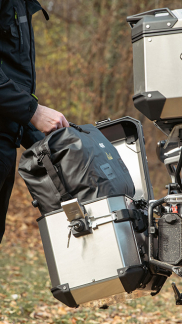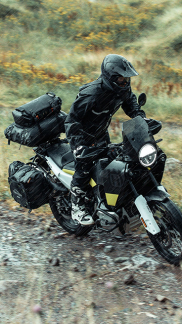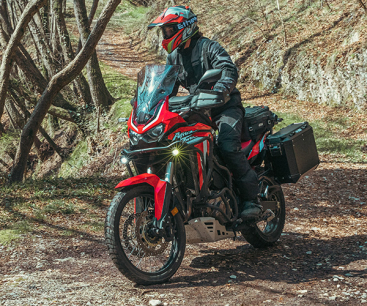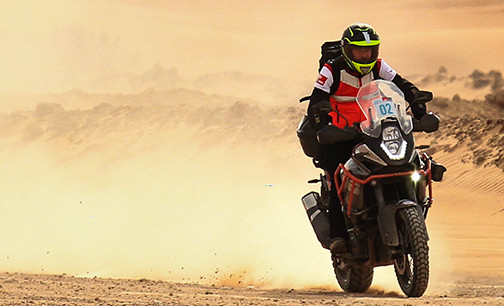How to prepare your motorcycle for rainy journeys
Rain is the sworn enemy of all those who travel on two wheels, transforming both long journeys and short trips across the city into nightmare scenarios. Roads become slippery and the risk of falling increases, not to mention the damage caused to luggage by water and humidity, as well as the discomfort of finding yourself utterly drenched after just a few minutes. However, with the right equipment, it’s possible to make it through the rain by motorcycle in complete safety and comfort.
While it’s always important to be prepared for the possibility of precipitation, it becomes absolutely essential to have all the proper equipment when travelling in areas where you’re particularly likely to encounter bad weather and strong winds, like the countries of Northern Europe. This is when waterproof clothing and accessories become genuine lifesavers.
Remember that there is a significant difference between the terms waterproof and water-resistant: the first indicates an ability to prevent water intrusion 100%, while the second only guarantees insulation in cases of high moisture or drizzle.
Below are a few practical tips to make sure your trip isn’t ruined.
WATERPROOF BAGS AND CASES
Whether you’re dealing with a light but relentless shower or an unexpected downpour, it’s essential to make sure that the contents of your luggage are well insulated from water, especially if you’re carrying books, clothing, or electronic devices like computers or cameras.
Hard cases are particularly resistant, and also offer luggage a high level of protection against impacts.
All motorcycle side cases and top cases from GIVI made from aluminium or plastic guarantee a degree of water resistance equivalent to heavy rainfall (over 20 ltr/min.); however, in extreme situations, a few drops may find their way inside.
To resolve this problem, or simply to ensure complete peace of mind, specific waterproof inner bags are available, like the T506, T507, T511 and T512 models.
If, on the other hand, you select a set of soft bags either as your main solution or as the finishing touch to a “hard” set-up, heat-sealed models are available to guarantee complete impermeability, while other fabric bags have a waterproof inner bag. Non-waterproof fabric models may, in any case, feature a waterproof external covering.
Do your travels bring you to places where the weather can be unpredictable?
Do they involve off-road stretches?
If so, you’re better off opting for bags in a heat-sealed waterproof material, with a watertight roll-top closure. The GIVI models with these features include, for example, the Canyon side bags, the GRT712B cylinder bag for saddles or racks, and the GRT715 and GRT716 tank bags.
There are lots of smaller accessories which can prove useful when travelling through the rain by motorcycle.
First of all, it’s important to protect yourself from the downpour as much as possible and to maintain clear visibility of the road. For this, you might find it useful to have an additional spoiler or a windscreen which is adjustable or at least larger than the standard size, or even hand guards and foot guards.
Your smartphone holder or navigator holder should also be water resistant, while various models of motorcycle covers exist to protect your vehicle while it’s parked, outside your hotel overnight for example.
Finally, it’s also important not to overlook mechanical part protection for motorcycles, indispensable in the event of a fall. However, this is a topic to which we will dedicate an editorial of its own.
MOTORCYCLE CLOTHING
In addition to dedicated motorcycle equipment, it’s also crucial to have appropriate technical clothing which can protect you perfectly from water and humidity, without compromising on adequate levels of breathability and overheating prevention (particularly in summer).
If you don’t have a four-seasons motorcycle suit (waterproof and layered), you can protect yourself by picking out accessories as needed. Here are a few:
- A waterproof suit or poncho to wear over your clothes. These come in a variety of types, from one-piece suits with a zip to separate jacket-and-trousers combinations, and even poncho-style capes which are quicker to get on but probably less water-resistant.
- Waterproof gloves or glove covers, which are more suitable during the summer months when the best option is perforated gloves which can be made waterproof when and as needed.
- Waterproof footwear or shoe-covers. As is the case for gloves, shoe-covers are better in summer if wearing highly breathable shoes.
- Helmets will need an anti-fog visor, so models featuring the Pinlock system are worth taking into consideration.







